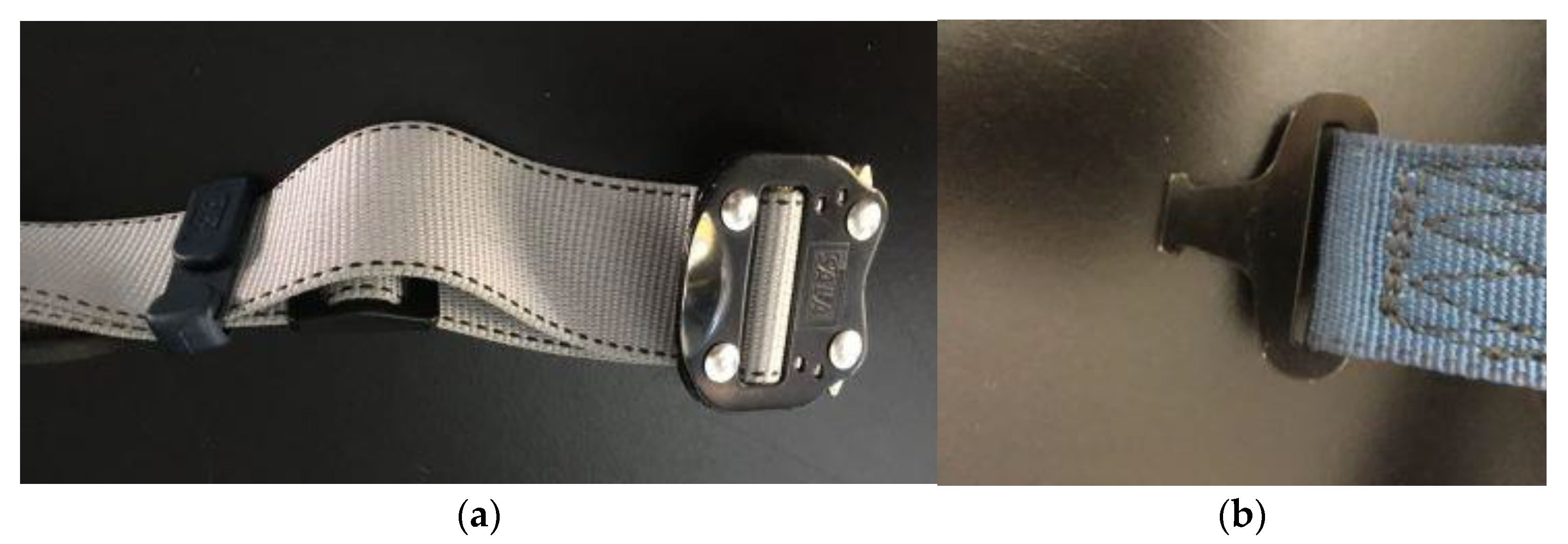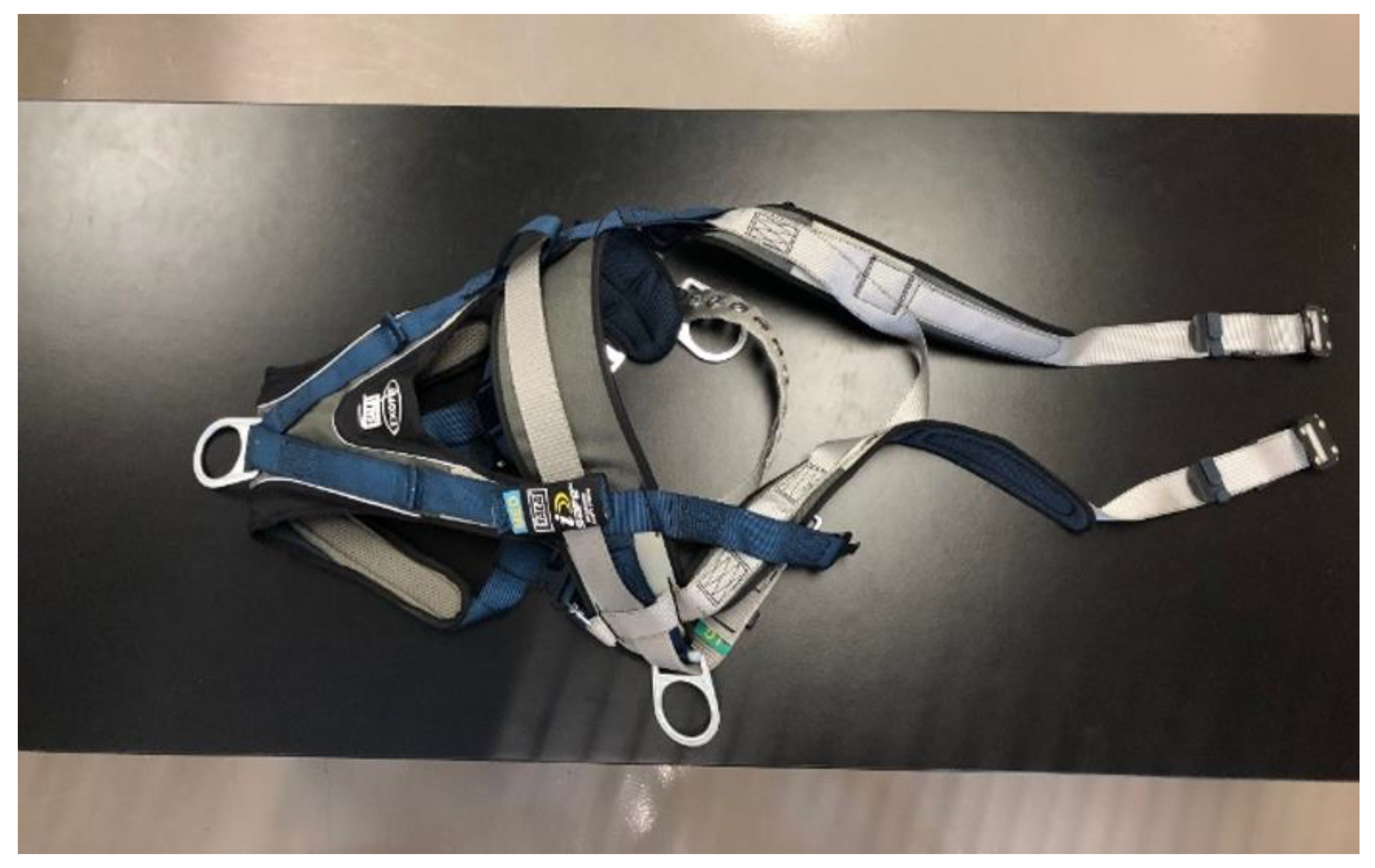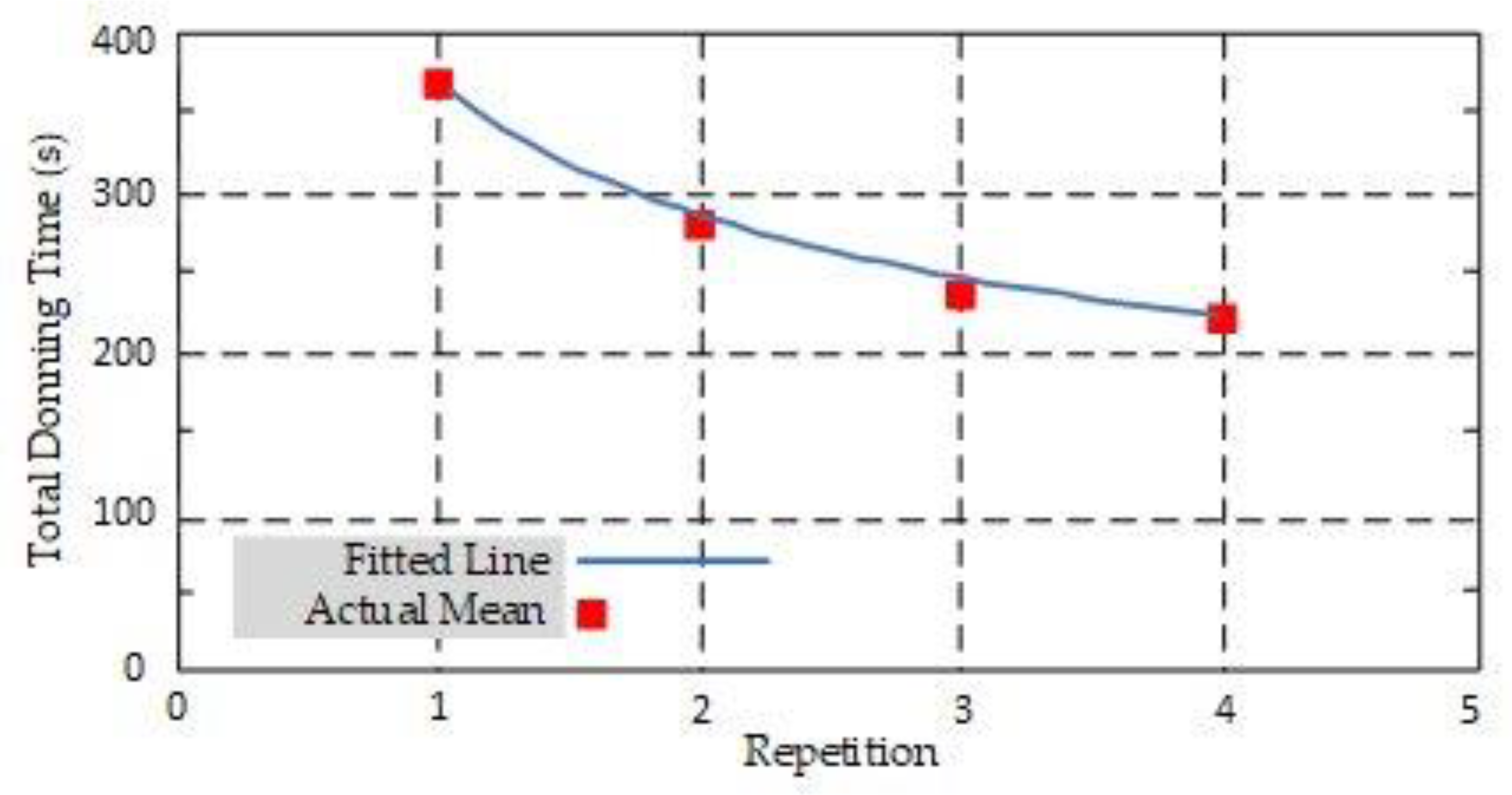Fall-Protection Harness Training: Donning Skill Improves with Up to Four Repetitions
Abstract
:1. Introduction
1.1. Occupational Fatalities in the United States
1.2. Strategies for Reducing Risk of Falls
- Eliminating the fall hazard;
- Preventing fall hazards, by guarding or restraint;
- Arresting falls after they occur; and
- Applying administrative techniques as a last resort.
- Effective training “requires attention to improving worker’s knowledge and skills specific to fall protection, as well as their preparation through the availability of proper equipment along with hands-on training.”
- Effective fall-protection training should be organized so it mimics as closely as possible the actual work environment and practices.
- Employees should be given an opportunity to practice and apply learned knowledge and skills.
1.3. Research on Personal Fall-Protection Harnesses
- The thigh strap should be snug but should not cut off circulation. This is a comfort issue when standing but becomes a safety issue in post-fall suspension. The rule of thumb is that no more than two fingers should be able to be inserted between the thigh strap and the thigh.
- The chest strap should fall just below the sternum. Inadequate chest ring location can interfere with a person’s work, especially for female workers.
- The harness should hold the body no more than 30 degrees off vertical in suspension. This is a safety as well as a comfort issue. With loose shoulder straps, the angle of the suspended person is increased.
- The back D-ring should fall between the shoulder blades. This helps distribute the force of the fall arrest over the body’s frame.
1.4. Research Issue and Project Aim
2. Materials and Methods
2.1. Experimental Design
2.2. Recruiting Subjects
2.3. Equipment
2.4. Procedure
2.4.1. Preliminary Steps
2.4.2. Harness and Donning Procedures
- Leg strap tightness appeared too tight, too loose, or adequate;
- Chest strap position appeared too low, too high, or mid-chest;
- Shoulder strap adjustment appeared too tight on shoulders, too loose on shoulders, and at reasonable tension; and
- Location of dorsal D-ring appeared too low, too high, or in between shoulder blades.
2.4.3. Preparing Time Data for Analyses
- Videotapes of each subject performing each repetition were transferred to a computer;
- The video recordings were reviewed with the aid of Observer XT software (Version 11, Noldus Information Technology, Inc., Leesburg, VA, USA) to determine times for each step [29];
- Time data were transferred to a Microsoft Excel® spreadsheet (Release 2019, Microsoft Corporation, Edmonds, WA, USA) for limited analyses;
- The data were copied to Minitab statistical software (Release 2019, Minitab Corporation, State College, PA, USA) for statistical analyses [30].
2.4.4. Programming Observer XT 11 Software
2.5. Analyses
3. Results
3.1. Subjects Demographics
3.2. Components of Total Donning Time
3.3. Coach’s Observations
4. Discussion
4.1. Study Limitations
4.2. Possible Future Work
5. Conclusions
Supplementary Materials
Author Contributions
Funding
Institutional Review Board Statement
Informed Consent Statement
Data Availability Statement
Acknowledgments
Conflicts of Interest
References
- Ellis, J.N. Introduction to Fall Protection, 4th ed.; American Society of Safety Engineers: Des Plaines, IL, USA, 2011. [Google Scholar]
- Bureau of Labor Statistics, U.S. Department of Labor. 2018 Census of Fatal Occupational Injuries (Final Data). Table A-3, Industry by Private Sector, Government Workers, and Self-Employed Workers. 2018. Available online: https://www.bls.gov/iif/oshwc/cfoi/cftb0324.htm (accessed on 26 April 2019).
- Bureau of Labor Statistics, U.S. Department of Labor. Census of Fatal Occupational Injuries 2018 (Final Data). Rate of Fatal Work Injuries Per 100,000 Full-Time Equivalent Workers by Employee Status. 2018. Available online: https://www.bls.gov/charts/census-of-fatal-occupational-injuries/number-and-rate-of-fatal-work-injuries-by-industry.htm (accessed on 18 June 2020).
- U. S. Department of Commerce, North American Industrial Classification System. Available online: https://www.bls.gov/bls/naics.htm (accessed on 24 October 2020).
- Bureau of Labor Statistics, U.S. Department of Labor. Census of Fatal Occupational Injuries 2018 (Final Data). Fatal Occupational Injuries by Occupation and Event or Exposure, all United States. 2018. Available online: https://www.bls.gov/charts/census-of-fatal-occupational-injuries/fatal-occupational-injuries-by-event-drilldown.htm (accessed on 18 June 2020).
- ANSI/ASSE Z 359—2016. Minimum Requirements for a Comprehensive Managed Fall Protection Program; American Society of Safety Professionals: Des Plaines, IL, USA, 2016.
- Jensen, R.C. Risk-Reduction Methods for Occupational Safety and Health, 2nd ed.; Wiley: Hoboken, NJ, USA, 2020; pp. 65–73. ISBN 978-111-949-399-0. [Google Scholar]
- United States, 29 Code of Federal Regulations, Subpart M—Fall Protection, 1926.501 and 1926.503. Available online: https://www.law.cornell.edu/cfr/text/29/part-1926/subpart-M (accessed on 7 January 2021).
- United States, 29 Code of Federal Regulations, Subpart R—Steel Erection, 1926.761. Available online: https://www.law.cornell.edu/cfr/text/29/part-1926/subpart-R (accessed on 7 January 2021).
- United States, 29 Code of Federal Regulations, Subpart D—Walking-Working Surfaces. 1910.30. Available online: https://www.law.cornell.edu/cfr/text/29/part-1910/subpart-D (accessed on 7 January 2021).
- United States Department of Labor—Occupational Safety and Health Administration Fall Protection. Commonly Used OSHA Data & Statistics. Available online: https://www.osha.gov/oshstats/commonstats.html (accessed on 1 July 2020).
- Dong, X.S.; Largay, J.A.; Choi, S.D.; Wang, X. Fatal falls and PFAS use in the construction industry: Findings from the NIOSH FACE reports. Accid. Anal. Prev. 2017, 102, 136–143. [Google Scholar] [CrossRef] [PubMed] [Green Version]
- Adams, S.J. Improving safety instruction & results: Five principles. Prof. Saf. 2000, 45, 40–41. [Google Scholar]
- Galbraith, D.D.; Fouch, S.E. Principles of adult learning: Application to safety training. Prof. Saf. 2007, 52, 35–49. [Google Scholar]
- Burke, M.J.; Sarpy, S.A.; Smith-Crowe, K.; Chan-Serafin, S.; Salvador, R.O.; Islam, G. Relative effectiveness of worker safety and health training methods. Am. J. Public Health 2006, 96, 315–324. [Google Scholar] [CrossRef] [PubMed]
- McCurley, L. Fall rescue: Training and practice. In Fall Prevention and Protection: Principles, Guidelines, and Practices; Hsiao, H., Ed.; CRC: Boca Raton, FL, USA, 2017; p. 318. [Google Scholar]
- Hsiao, H.; Bradtmiller, B.; Whitestone, J. Sizing and fit of fall-protection harnesses. Ergonomics 2003, 46, 1233–1258. [Google Scholar] [CrossRef] [PubMed]
- Hsiao, H. Suspension trauma and fall-arrest harness design. In Fall Prevention and Protection: Principles, Guidelines, and Practices; Hsiao, H., Ed.; CRC: Boca Raton, FL, USA, 2017; pp. 109–114. [Google Scholar]
- Hsiao, H.; Turner, N.; Whisler, R.; Zwiener, J. Impact of harness fit on suspension tolerance. Hum. Factors 2012, 54, 346–357. [Google Scholar] [CrossRef] [PubMed] [Green Version]
- Welford, A.T. Fundamentals of Skill; Methuen: London, UK, 1960; pp. 316–321. [Google Scholar]
- De Jong, J.R. The effects of increasing skill on cycle time and its consequences for time standards. Ergonomics 1957, 1, 51–60. [Google Scholar] [CrossRef]
- Nanda, R. Learning curves: An overview. In Learning Curves, Theory and Application; Nanda, R., Alder, G.L., Eds.; Industrial Engineering and Management Press: Norcross, GA, USA, 1982; pp. 1–5. [Google Scholar]
- Hancock, W.M.; Bayha, F.H. The learning curve. In Handbook of Industrial Engineering; Salvandy, G., Ed.; John Wiley: New York, NY, USA, 1982; pp. 4.3.1–4.3.10. [Google Scholar]
- Crossman, E.R.F.W. A theory of the acquisition of speed-skill. Ergonomics 1959, 2, 153–166. [Google Scholar] [CrossRef]
- Yeolekar, A.; Qadri, H. The learning curve in surgical practice and its applicability to rhinoplasty. Indian J. Otolaryngol. Head Neck Surg. 2018, 70, 38–42. [Google Scholar] [CrossRef] [PubMed]
- 3M Fall Protection. DBI Sala ExoFitTM Construction Style Harness, Back D-Ring, Belt with Pad and Side D-Rings. Part Numbers DBI-1108500-1108502 and 1108507. Available online: https://www.3m.com/3M/en_US/company-us/all-3m-products/~/3M-DBI-SALA-ExoFit-Construction-Style-Positioning-Harness-1108507-X-Large-1-EA/?N=5002385+3291832291&rt=rud (accessed on 7 January 2021).
- DBI Sala Full Body Harness Sizing Chart. Available online: https://www.barry-usa.com/pages/full-body-harness-sizing-chart (accessed on 30 October 2020).
- Bunney, Z. Effects of Repetition on Time to Don and Adjust a Fall Protection Harness. Master’s Thesis, Montana Technological University, Butte, MO, USA, 2019. [Google Scholar]
- Noldus Information Technology, Inc. Observer XT (Version 11); Noldus Information Technology, Inc.: Leesburg, VA, USA, 2020. [Google Scholar]
- Minitab. Minitab Statistical Software®, Release 2019; Minitab: State College, PA, USA, 2019. [Google Scholar]
- Rossi, R.J. Applied Biostatistics for the Health Sciences; Wiley: Hoboken, NJ, USA, 2010; pp. 521–533. [Google Scholar]






| Industry Group per NAICS | Number of Fatalities a | Number Fatalities from Falls | Prct. from Falls | Occupational Fatality Rate b |
|---|---|---|---|---|
| Construction | 1038 | 338 | 33.5 | 9.5 |
| Agriculture, Forestry, Fishing, Hunting | 574 | 35 | 6.1 | 23.4 |
| Manufacturing | 343 | 46 | 13.4 | 2.0 |
| Mining, Quarrying, and Oil Extraction | 130 | 7 | 2.1 | 14.1 |
| Event Preceding Fatal Fall | Number | Percentage |
|---|---|---|
| Fall to a lower level | 615 | 79.25 |
| Fall on the same level | 154 | 19.84 |
| Slip or trip without fall | 4 | 0.52 |
| Jumps to a lower level | 3 | 0.39 |
| Sum | 776 | 100 |
| Gender | Number | Height (mm) | SD | Height Range | Weight (Kg) | SD | Weight Range |
|---|---|---|---|---|---|---|---|
| Male | 15 | 1796 | 69 | 1676–1880 | 75.4 | 14.7 | 47.6–92.0 |
| Female | 10 | 1720 | 89 | 1574–1880 | 69.2 | 6.9 | 56.7–82.1 |
| Steps | Repetition 1 Mean (SD) | Repetition 2 Mean (SD) | Repetition 3 Mean (SD) | Repetition 4 Mean (SD) |
|---|---|---|---|---|
| Shake Out | 3.7 (0.9) | 3.9 (1.1) | 3.5 (0.7) | 3.4 (0.3) |
| Over the Shoulders | 6.9 (3.5) | 7.2 (3.2) | 6.0 (0.4) | 5.4 (1.3) |
| Legs | 211.4 (83.0) | 147.0 (38.0) | 121.6 (65.8) | 112.5 (8.4) |
| Chest | 47.0 (31.5) | 39.0 (6.9) | 33.8 (0.2) | 30.0 (0.3) |
| Shoulder/Belt Adjust | 100.8 (42.8) | 81.9 (7.2) | 71.3 (14.2) | 71.0 (24.3) |
| Total | 367.9 (102.5) | 287.1 (47.1) | 242.9 (33.0) | 225.3 (17.6) |
| Step | Term | Adj. MS | F-Value | p-Value | Significant Differences in R |
|---|---|---|---|---|---|
| Shake Out | Trial | 1.06 | 1.08 | 0.363 | None |
| Error | 0.98 | ||||
| Over the Shoulder | Trial | 13.94 | 2.03 | 0.115 | None |
| Error | 6.86 | ||||
| Legs | Trial | 43,760.0 | 10.71 | 0.000 | 2 − 1, 3 − 1, 4 − 1 |
| Error | 4084.0 | ||||
| Chest | Trial | 1193.5 | 2.43 | 0.071 | None |
| Error | 492.1 | ||||
| Shoulder/Belt Adjust | Trial | 4299 | 3.95 | 0.011 | 3 − 1, 4 − 1 |
| Error | 1088 | ||||
| Total time | All steps | 89,075.0 | 12.06 | 0.000 | 2 − 1, 3 − 1, 4 − 1 |
| Error | 7384 |
Publisher’s Note: MDPI stays neutral with regard to jurisdictional claims in published maps and institutional affiliations. |
© 2021 by the authors. Licensee MDPI, Basel, Switzerland. This article is an open access article distributed under the terms and conditions of the Creative Commons Attribution (CC BY) license (http://creativecommons.org/licenses/by/4.0/).
Share and Cite
Bunney, Z.; Jensen, R.C.; Autenrieth, D. Fall-Protection Harness Training: Donning Skill Improves with Up to Four Repetitions. Safety 2021, 7, 16. https://0-doi-org.brum.beds.ac.uk/10.3390/safety7010016
Bunney Z, Jensen RC, Autenrieth D. Fall-Protection Harness Training: Donning Skill Improves with Up to Four Repetitions. Safety. 2021; 7(1):16. https://0-doi-org.brum.beds.ac.uk/10.3390/safety7010016
Chicago/Turabian StyleBunney, Zachary, Roger C. Jensen, and Daniel Autenrieth. 2021. "Fall-Protection Harness Training: Donning Skill Improves with Up to Four Repetitions" Safety 7, no. 1: 16. https://0-doi-org.brum.beds.ac.uk/10.3390/safety7010016





